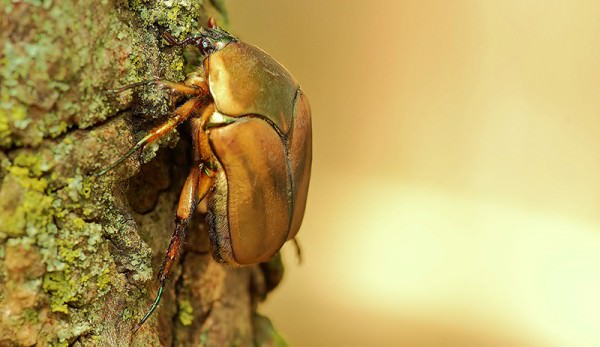
Whether playing in the yard, exploring the woods or splashing in the creek, my childhood was spent outdoors in and around nature. One of my most vivid reoccurring summertime memories involves laying in the green grass watching the clouds float by. The memory is not silent, rather it was filled with loud drone of male June bugs, aka June beetles, flying about the yard. These insects were always a chronological marker indicating that mid-summer was here and school would soon be on the horizon.
Identifying The June Beetle
The June beetle (Cotinis nitida) is a large scarab beetle found in the eastern half of North America. It’s a shiny metallic green with rusty red highlights along the periphery of the body. Adult beetles reach about 1 inch long and nearly 1/2 inch wide. The color and size are two of the most important characteristics for identifying these beetles as adults.
There is only one generation of these insects each year. In late summer, female beetles lay eggs, which will hatch quickly begin to seek out decaying organic matter to eat. The feeding and tunneling of the larval June beetles can injure and loosen grasses and young plants when the grubs are found in high numbers. After feeding in the fall, the large whitish grubs will then overwinter and become active again in the early spring. Even though they are known as June bugs, the adult beetles don’t usually emerge until late June, July or even early August depending on your climatic zone.

The Destruction Ensues
Once the adult beetles crawl out of the ground, they’re only interested in two things: finding a mate and feeding. The feeding habits of the adult green June beetles can cause problems for growers of thin skinned fruits like grapes, apples, peaches and figs, because they’re attracted to and will happily nosh on the over-ripe fruits. And once one beetle finds a suitable fruit, just wait—others will be close behind. The beetle will emit an aggregation pheromone that will draw in all nearby beetles for a tasty feast that can cause some serious economic damage for fruit growers.
Fortunately, unless you are trying to maintain a perfectly manicured turf grass lawn, large pastures or have a numerous fruit trees, normal populations of green June beetles do not pose a real threat for most gardeners or homeowners. If large populations are present, there are some organic controls and pesticides available on the commercial market, but I highly recommend talking to your local extension agent about any potential treatments as ideal management plans differ regionally.




